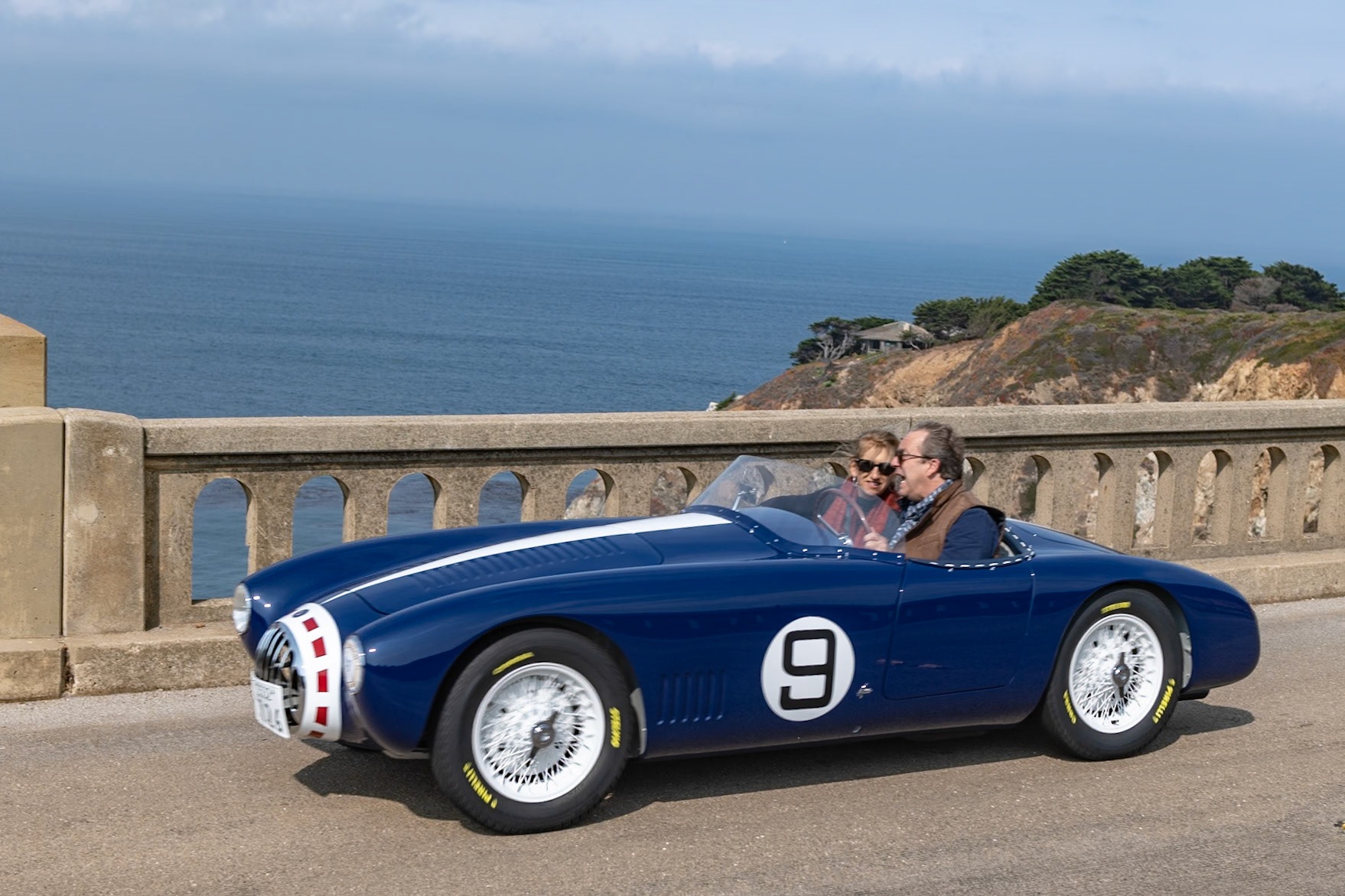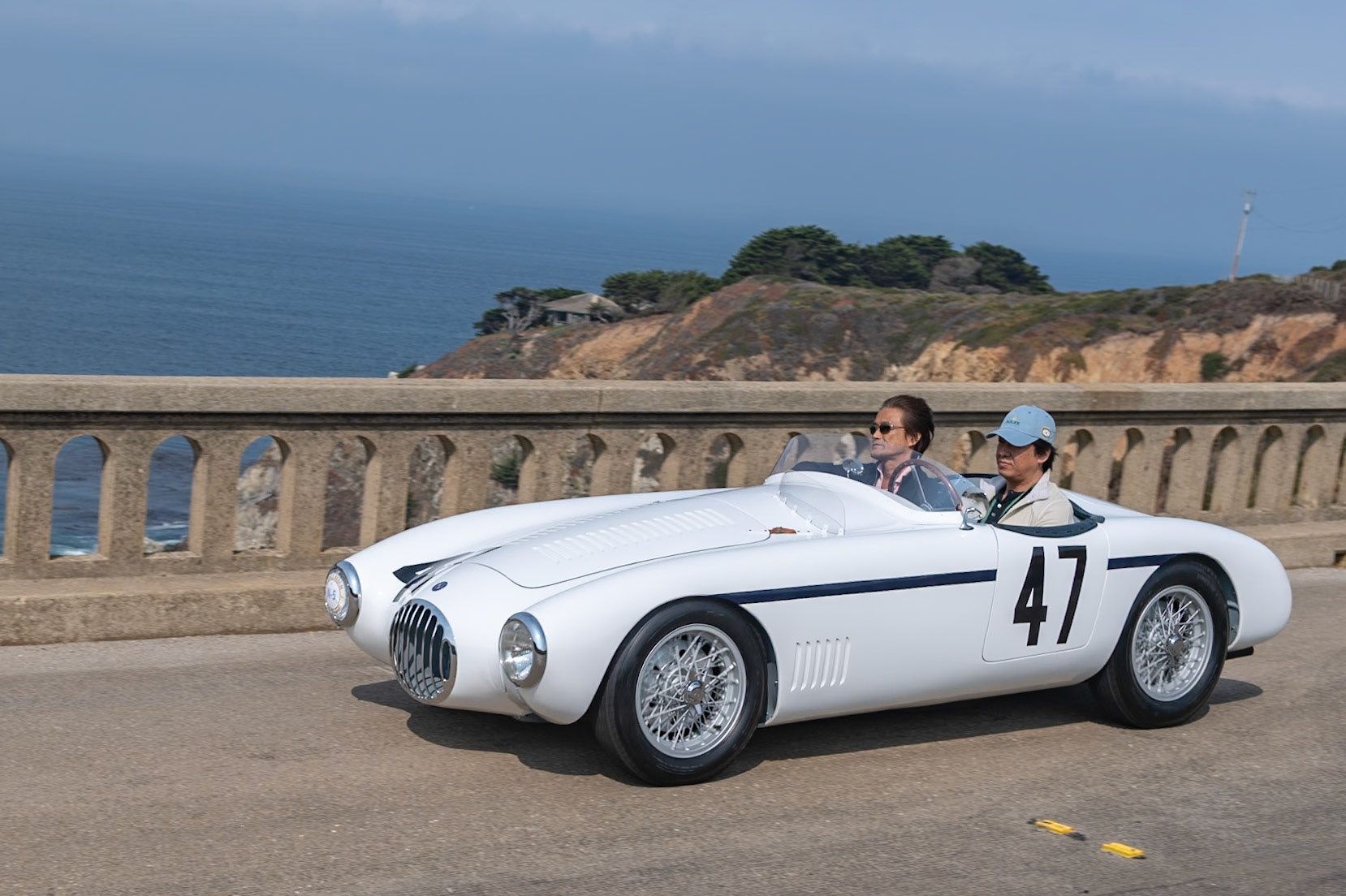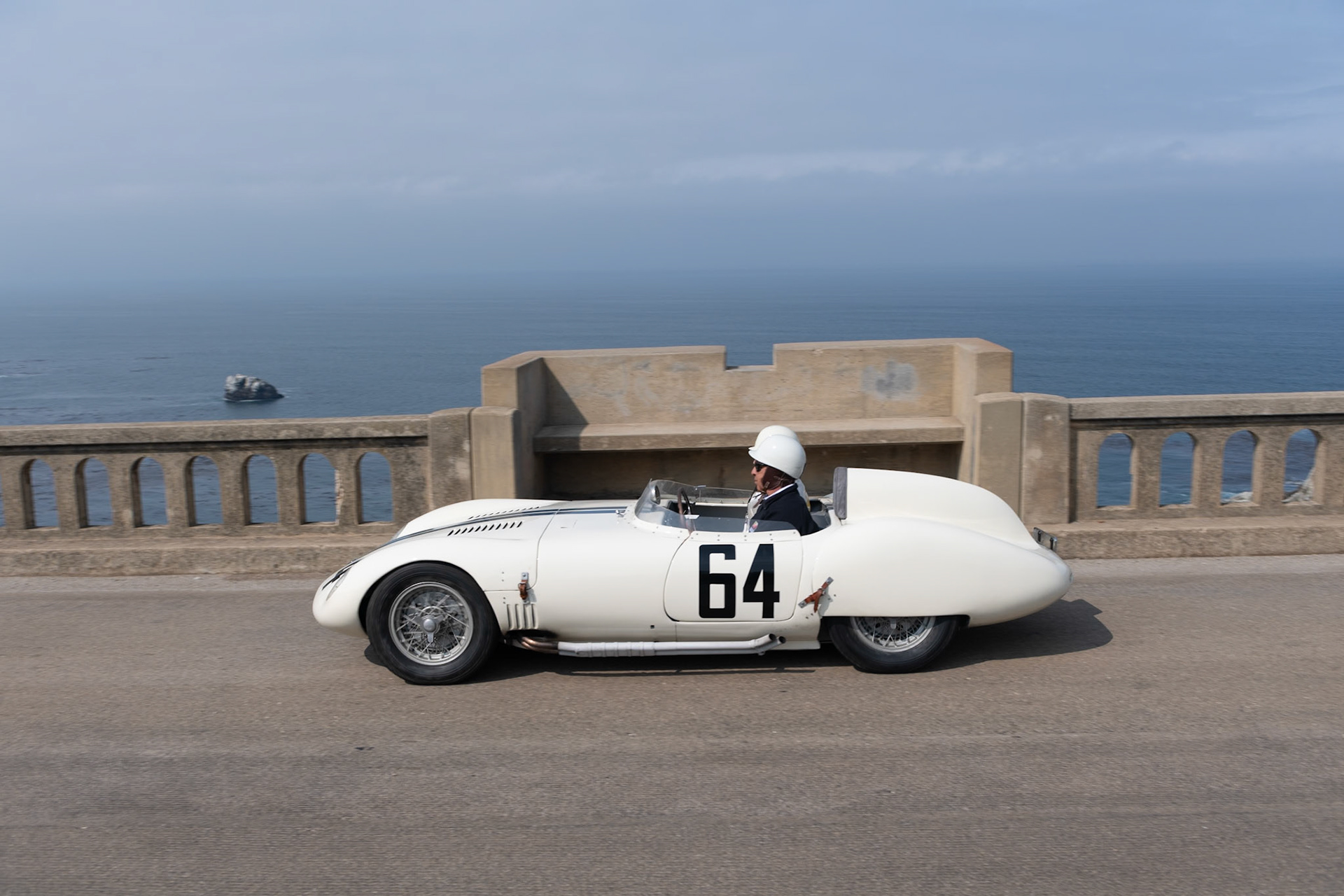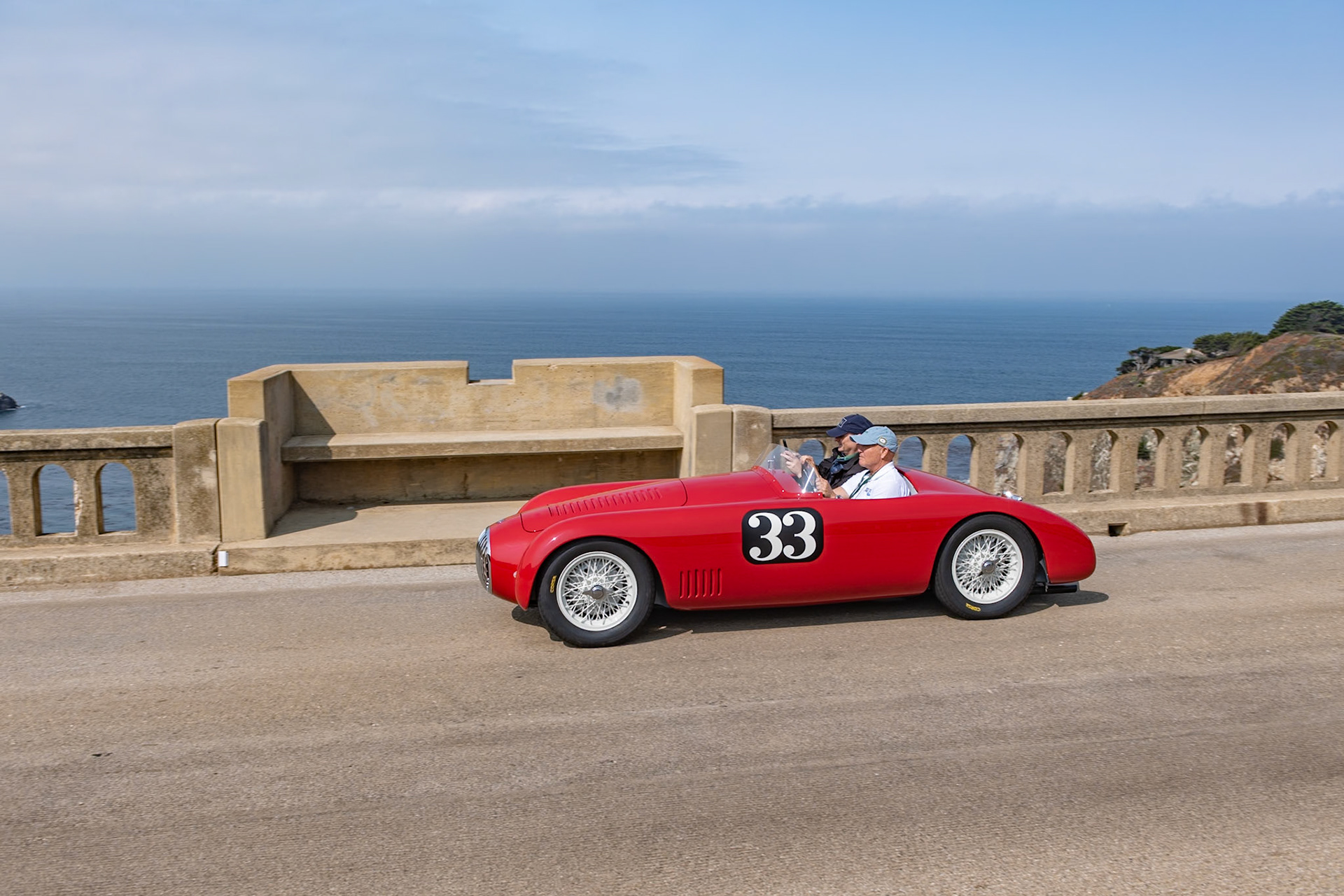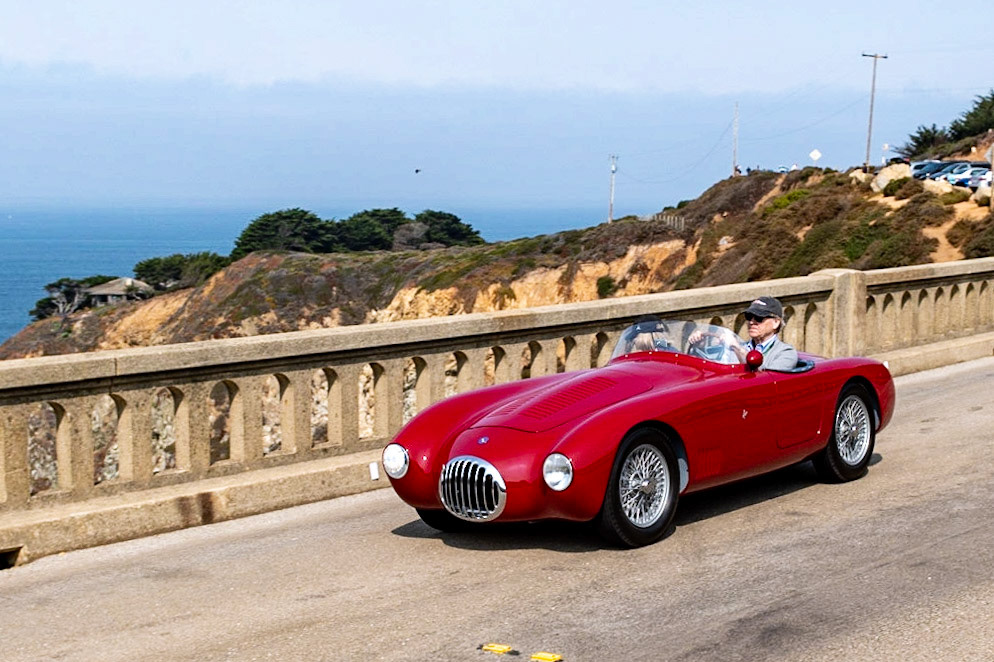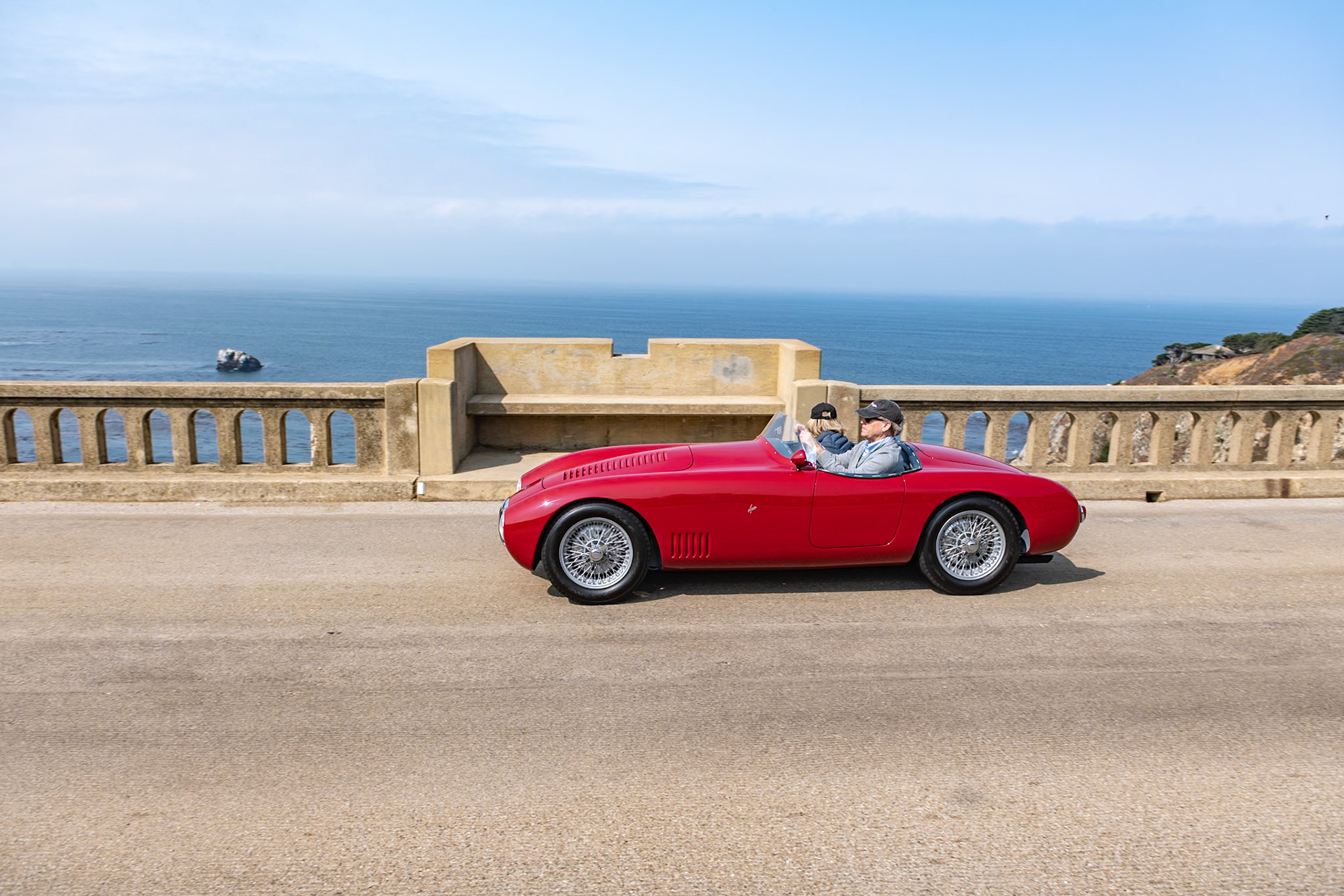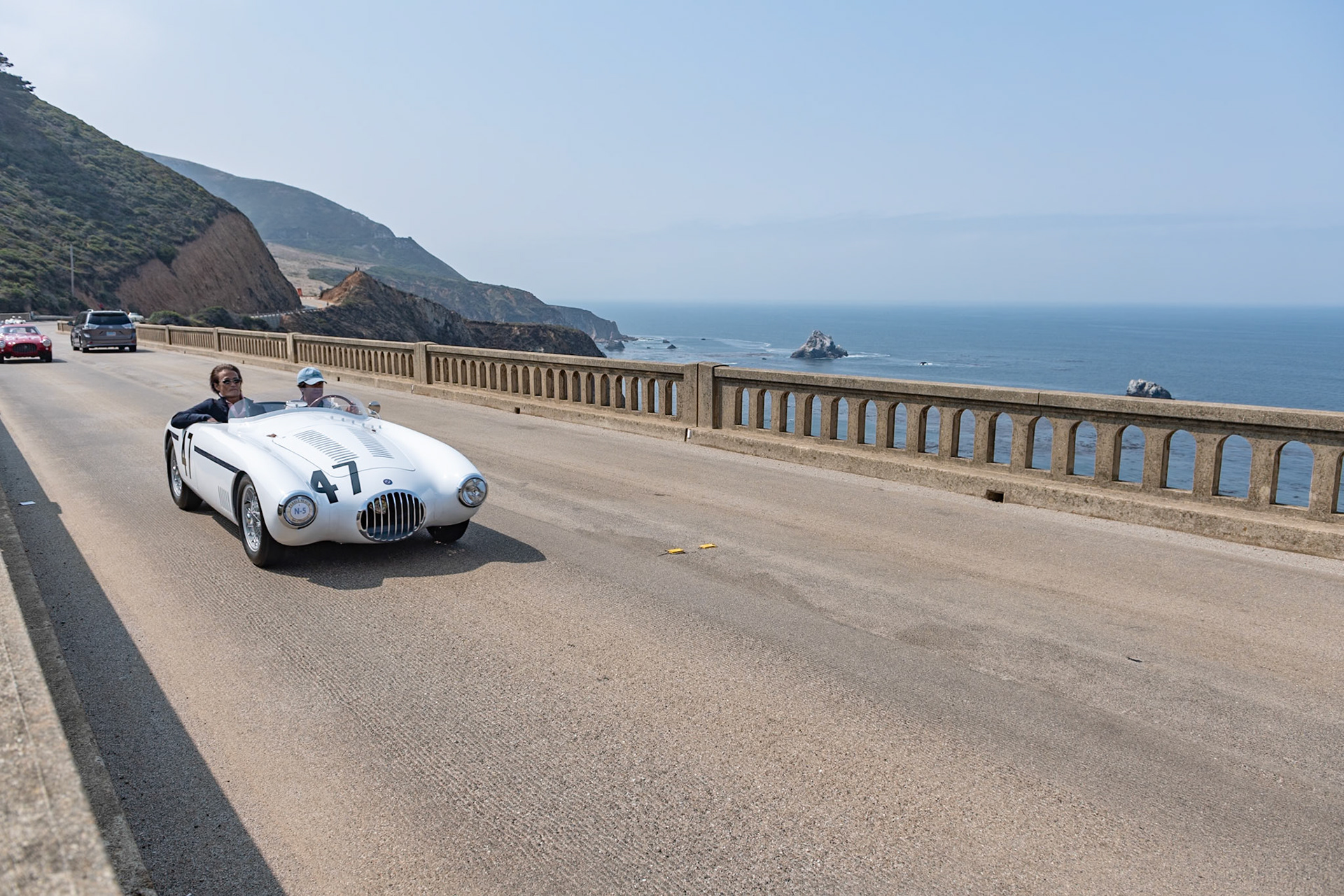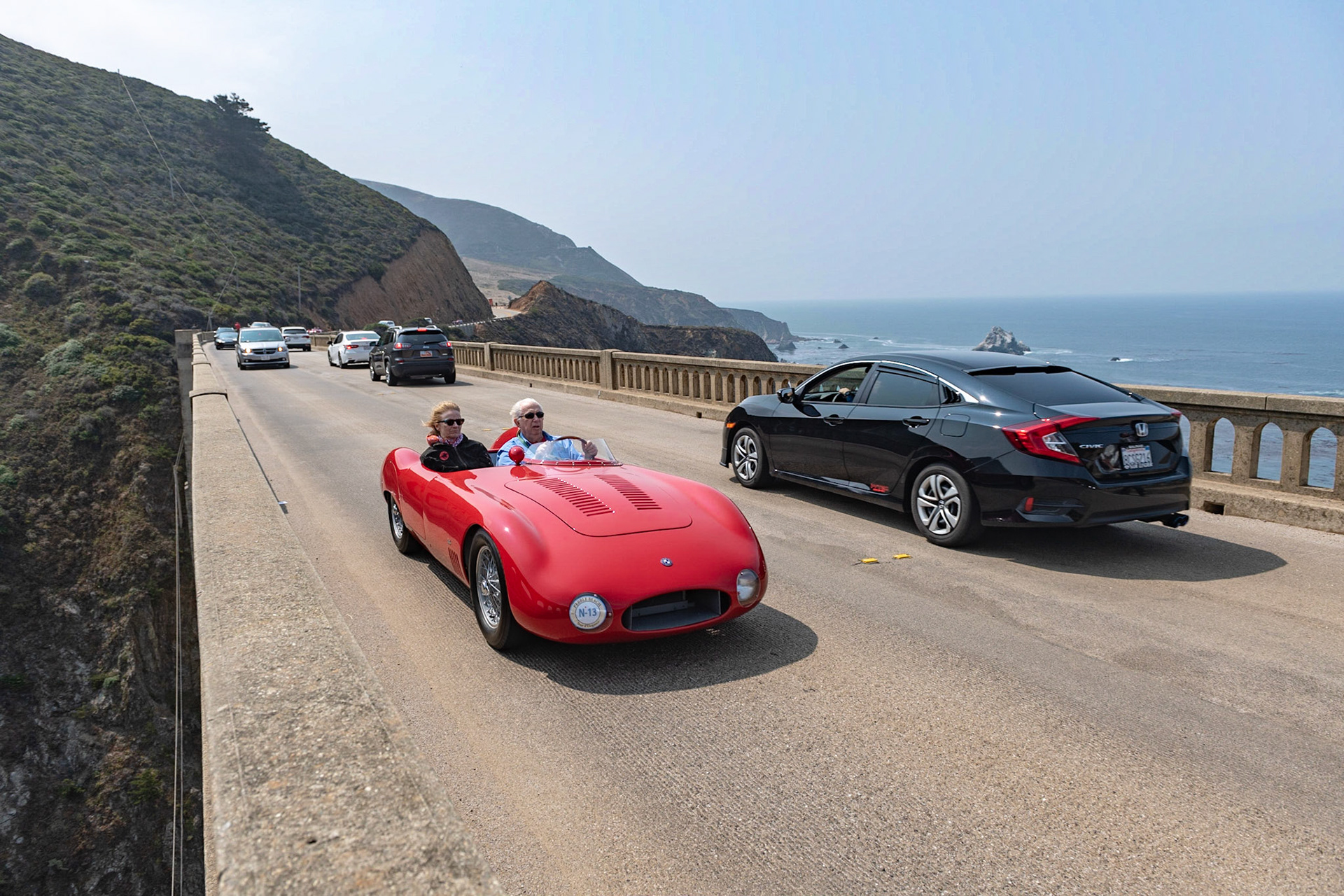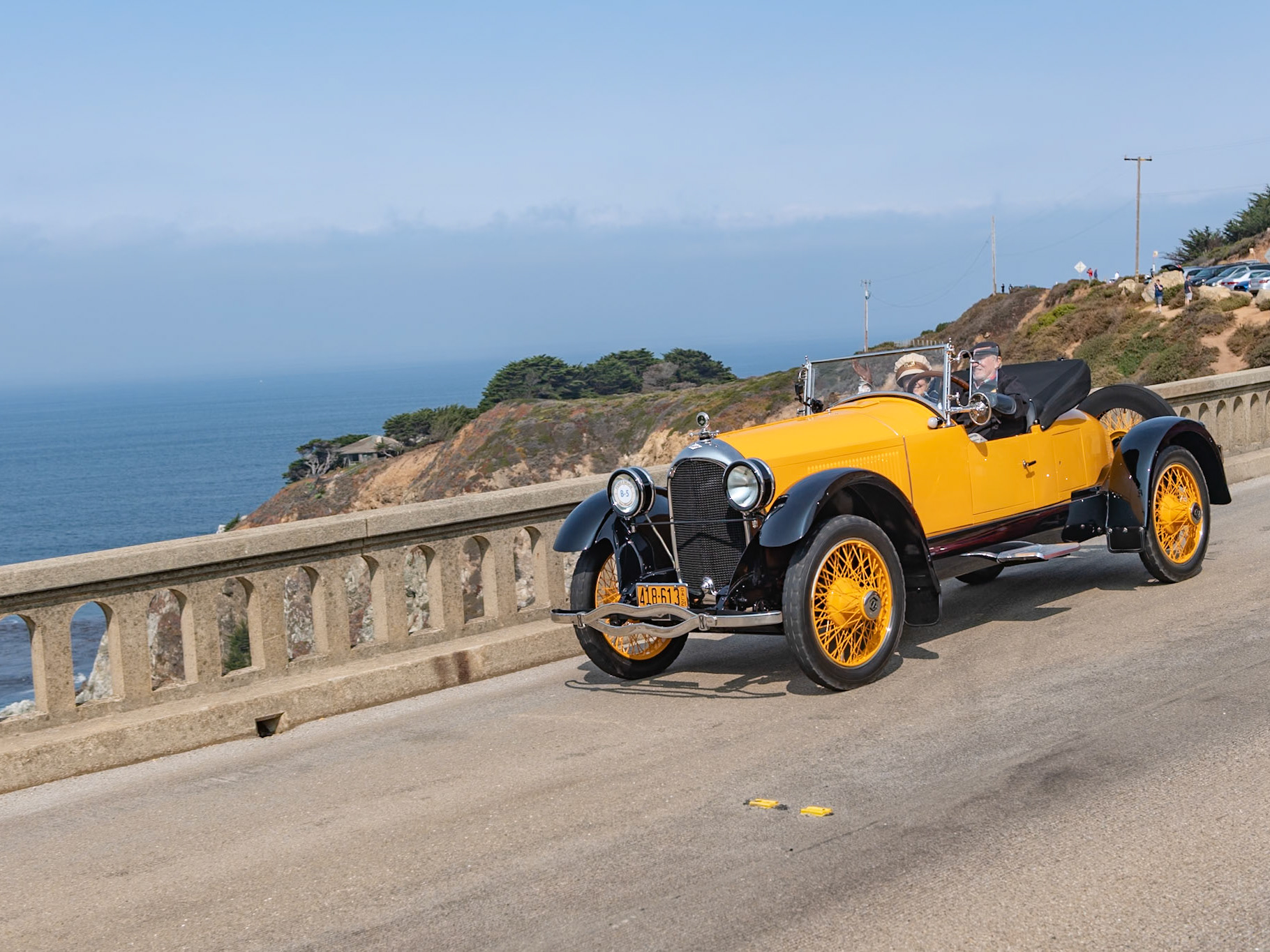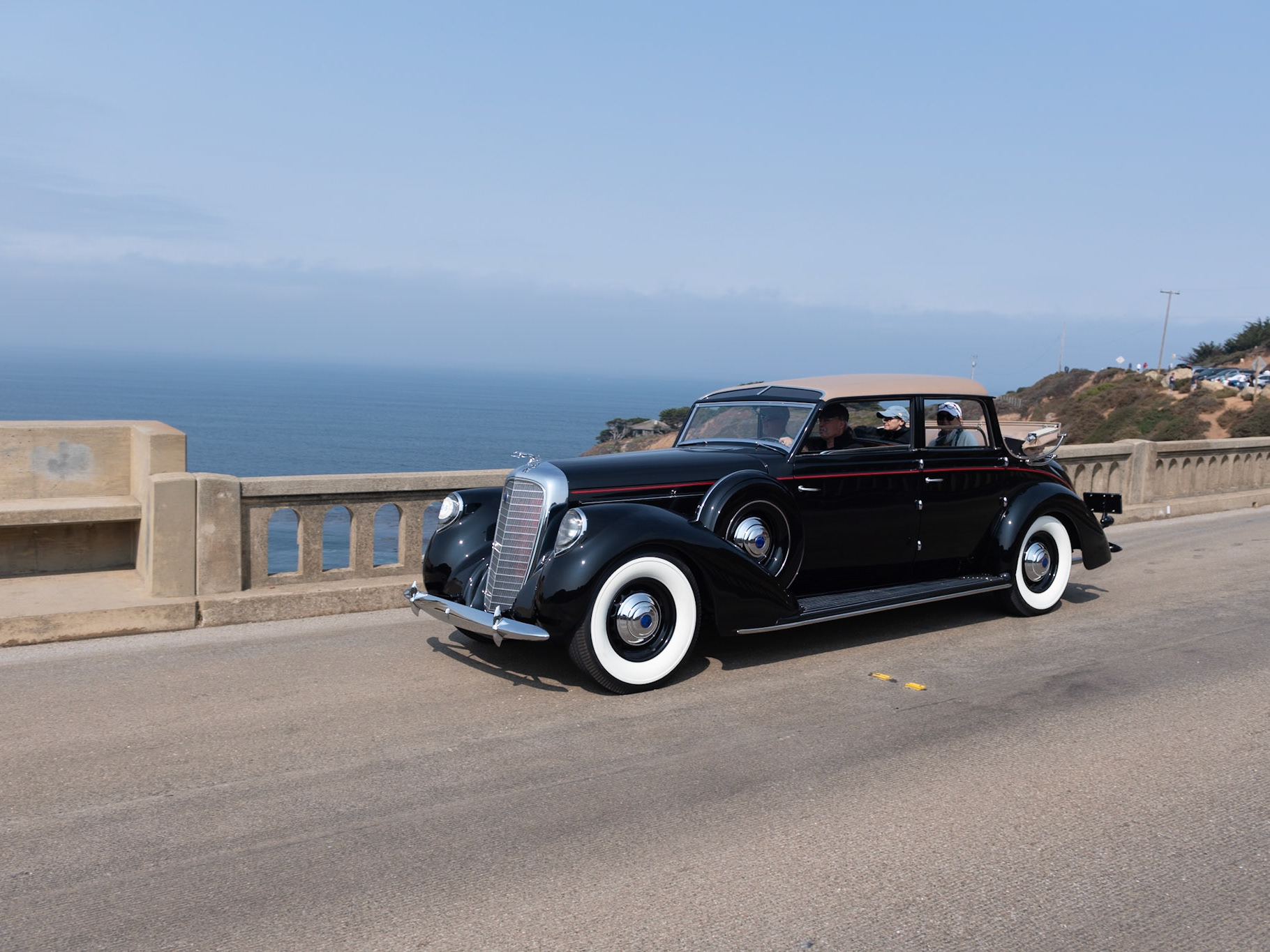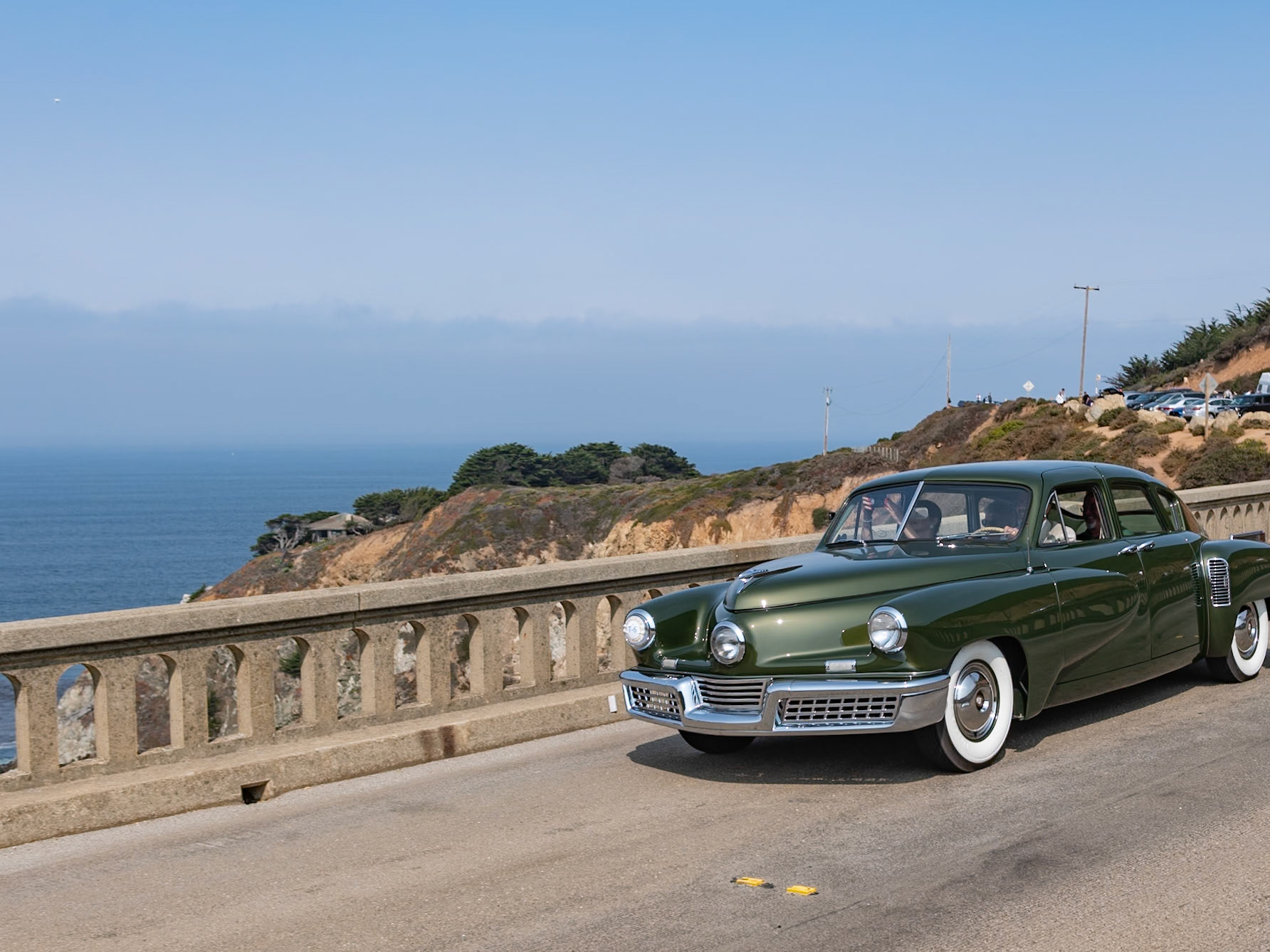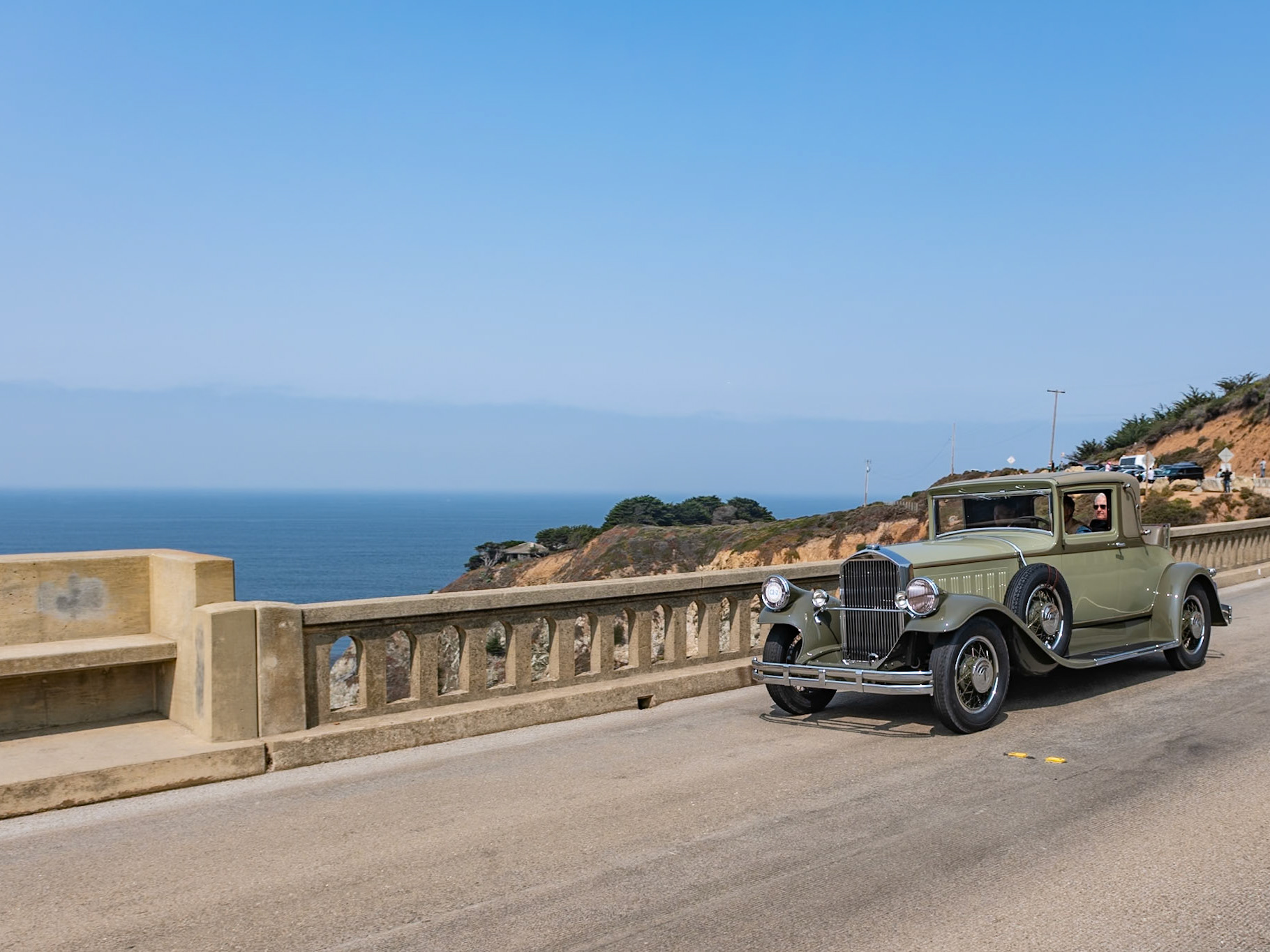
This OSCA MT4 (chassis 1114) was built by the factory in a more traditional spider-style. It had headlights within the oval grille so it could compete in the 1951 Mille Miglia, where it placed second in class driven by Franco Bordoni. For the rest of the season, with OSCA factory driver Giulio Cabianca at the wheel, it achieved a remarkable 14 class victories and 9 overall wins. In 1952 the body was prepared for the 24 Hours of Le Mans, with additional lighting cut into the fenders—but then the car didn’t race there. After buying a larger 1,350 cc OSCA engine, Cabianca added 8 wins to his 14 previous wins, for a total of 22 victories in 2 years. The car was then sold it to Al Garthwaite of Philadelphia and was entered in the 1953 Watkins Glen Grand Prix for Jim Kimberly, who finished second in class. Later, the car was sold to Otto Linton, who raced it at Sebring in 1954, placing third in class behind winner Stirling Moss. It’s last competitive appearance was in July 1956, when Linton finished second in class at the Brynfan Tyddyn circuit in Pennsylvania. This famous OSCA MT4 has been in the Mittler family since 2010.

Most of the OSCA bodies built prior to 1955 were constructed by the factory because there were few coachbuilders located near to its premises in Bologna. After Carrozzeria Morelli, based a few kilometres away in Ferrara, rebodied an OSCA MT4 in 1953, the Maserati brothers signed a contract for more OSCA bodies, and soon OSCA bodies made up 90 percent of Morelli’s business. Of all the 78 MT4 chassis built, Morelli was responsible for around 25 of them. This MT4 1500 (chassis 1168) has a rare streamlined Morelli body built for American racer Paul Pappalardo. Later owners included Richard Gent, James K. Wolosoft, Eric Bauer, and Joel Finn. Its current owner bought the car in 1995 and showed it at Pebble Beach in 1996. It has recently been restored for its return visit.

This is one of the first OSCA MT4s to be fitted with the 1450 cc 4-cylinder engine. It was originally delivered to the United States at the end of 1953. During the following 1954, SCCA season Bill David entered this MT4 (chassis 1135) in several races, including the Guardsman Championship races in San Francisco’s Golden Gate Park and the Seattle Seafair National Races, and he won his class both times. In 1955 David won his class at the Lions Presidential Cup at Stockton and again at Santa Rosa. After selling the car at the end of 1955, David continued to race other OSCAs all over America. This MT4 was acquired by its current owner in 2017, and it was shown at the Kyoto Concours in Japan. It has since been restored in Italy for its return to California after a gap of over 60 years.

Rees Makins was the first owner of this OSCA MT4 Spider, which was ordered, with the larger 1350 cc engine, via the OSCA importer Edgar Fronteras in Chicago. It first raced at Le Mans in 1953 where it was driven by Phil Hill, then in his first 24 hour race there, and Fred Wacker, then president of the SCCA. Unfortunately, the car eventually retired with gearbox problems. After Le Mans, the car traveled to the United States, where Makins drove it for the 1953 and 1954 seasons, which included the Sebring 12 Hour race. There the car won its class. The car was so successful in 1954 that Makins won that year’s Class G USSRC Championship. The car was bought by its current owner in 2003 and has recently been restored to the American livery it wore at its first race at Le Mans.

The OSCA S273 was originally designed for the 1100 cc OSCA engine, although this car (chassis 767) was fitted by the factory with the tiny 750 cc 4-cylinder, 75 bhp motor. It was ordered by Briggs Cunningham and was delivered in the summer of 1959 to Cunningham’s race manager, Alfred Momo in New York City, who prepared it for the Cunningham team. Cunningham owned several OSCAs in period, and the S273 was entered at six events during 1959. The car’s most significant race was at the 1960 12 Hours of Sebring, where it was co-driven by Denise McCluggage and Marianne Windridge. After that the car was not used again by the Cunningham team and was sold to privateer Cecil Schoeneman who drove it in several races in the Midwest. At this point, the original 750 cc engine was at the end of its life, and a larger 860 cc Tipo 187 engine was fitted. Then the car was sold to Dr. John Hunholz of Washington. He restored the OSCA, keeping it for the next four decades, until its current owner acquired the car in August 2015. It has now been restored again and wears its original Cunningham livery.

The OSCA S273 was originally designed for the 1100 cc OSCA engine, although this car (chassis 767) was fitted by the factory with the tiny 750 cc 4-cylinder, 75 bhp motor. It was ordered by Briggs Cunningham and was delivered in the summer of 1959 to Cunningham’s race manager, Alfred Momo in New York City, who prepared it for the Cunningham team. Cunningham owned several OSCAs in period, and the S273 was entered at six events during 1959. The car’s most significant race was at the 1960 12 Hours of Sebring, where it was co-driven by Denise McCluggage and Marianne Windridge. After that the car was not used again by the Cunningham team and was sold to privateer Cecil Schoeneman who drove it in several races in the Midwest. At this point, the original 750 cc engine was at the end of its life, and a larger 860 cc Tipo 187 engine was fitted. Then the car was sold to Dr. John Hunholz of Washington. He restored the OSCA, keeping it for the next four decades, until its current owner acquired the car in August 2015. It has now been restored again and wears its original Cunningham livery.

The OSCA S273 was originally designed for the 1100 cc OSCA engine, although this car (chassis 767) was fitted by the factory with the tiny 750 cc 4-cylinder, 75 bhp motor. It was ordered by Briggs Cunningham and was delivered in the summer of 1959 to Cunningham’s race manager, Alfred Momo in New York City, who prepared it for the Cunningham team. Cunningham owned several OSCAs in period, and the S273 was entered at six events during 1959. The car’s most significant race was at the 1960 12 Hours of Sebring, where it was co-driven by Denise McCluggage and Marianne Windridge. After that the car was not used again by the Cunningham team and was sold to privateer Cecil Schoeneman who drove it in several races in the Midwest. At this point, the original 750 cc engine was at the end of its life, and a larger 860 cc Tipo 187 engine was fitted. Then the car was sold to Dr. John Hunholz of Washington. He restored the OSCA, keeping it for the next four decades, until its current owner acquired the car in August 2015. It has now been restored again and wears its original Cunningham livery.

In 1954 OSCA introduced to the MT4 chassis an improved 2AD 1500-cc twin-spark engine, which produced well over 130 bhp. These OSCA MT4 2AD 1500s proved themselves time after time against cars with engines two, three and four times the MT4’s displacement. The superb design and exceptional build quality made it the car to beat in the 1500 cc class for almost a decade. This OSCA MT4 2AD 1500 Morelli Spider (chassis 1152) was sold new to Guatemalan racing driver Manfredo Lippmann for the 1954 Carrera Panamericana. After the race, he bought a Ferrari 250 Monza and left the OSCA at Luigi Chinetti’s Ferrari dealership. The car was paired for a short period with the talented Mexican racing drivers Pedro and Ricardo Rodríguez, then Lippmann reacquired it and had it completely restored. Over 50 years after he first bought it, Lippmann sold his MT4 1500 Spider to the current owners in 2007, and it has been enjoyed by them on many rallies and tours.

In 1954 OSCA introduced to the MT4 chassis an improved 2AD 1500-cc twin-spark engine, which produced well over 130 bhp. These OSCA MT4 2AD 1500s proved themselves time after time against cars with engines two, three and four times the MT4’s displacement. The superb design and exceptional build quality made it the car to beat in the 1500 cc class for almost a decade. This OSCA MT4 2AD 1500 Morelli Spider (chassis 1152) was sold new to Guatemalan racing driver Manfredo Lippmann for the 1954 Carrera Panamericana. After the race, he bought a Ferrari 250 Monza and left the OSCA at Luigi Chinetti’s Ferrari dealership. The car was paired for a short period with the talented Mexican racing drivers Pedro and Ricardo Rodríguez, then Lippmann reacquired it and had it completely restored. Over 50 years after he first bought it, Lippmann sold his MT4 1500 Spider to the current owners in 2007, and it has been enjoyed by them on many rallies and tours.

This little OSCA 750 S was known as “The Giant Killer.” Just 18 OSCA 750 S models were constructed, and all were intended for the 750 cc class in endurance racing to compete against the similar Lotus 11s, Fiat-Abarths, and Moretti 750s. The factory first entered a 750 at the 1956 24 Hours of Le Mans, and the car continued to race with various successes in Europe and the United States up until 1960. This car (chassis 769) is one of four OSCA 750s with a clamshell body. It was built by the factory for its first owner, John “Jack” Gordon, and in its first race season, it placed twelfth overall and first in its class at the 1960 Sebring 12 Hours, driven by Gordon and John Bentley. During the next five seasons, the car was raced at Sebring three more times and then at almost all the SCCA race meetings in the Northeast and Midwest, finishing in the top three places in over 80 percent of those races. Later owners included Peter Wessel and Oliver Collins, the latter of which raced it in 25 vintage races. The car was restored in the 1980s, and its current owner bought it in 2014.

This little OSCA 750 S was known as “The Giant Killer.” Just 18 OSCA 750 S models were constructed, and all were intended for the 750 cc class in endurance racing to compete against the similar Lotus 11s, Fiat-Abarths, and Moretti 750s. The factory first entered a 750 at the 1956 24 Hours of Le Mans, and the car continued to race with various successes in Europe and the United States up until 1960. This car (chassis 769) is one of four OSCA 750s with a clamshell body. It was built by the factory for its first owner, John “Jack” Gordon, and in its first race season, it placed twelfth overall and first in its class at the 1960 Sebring 12 Hours, driven by Gordon and John Bentley. During the next five seasons, the car was raced at Sebring three more times and then at almost all the SCCA race meetings in the Northeast and Midwest, finishing in the top three places in over 80 percent of those races. Later owners included Peter Wessel and Oliver Collins, the latter of which raced it in 25 vintage races. The car was restored in the 1980s, and its current owner bought it in 2014.

1955 OSCA MT4 Morelli Spyder
John & Jan Grosseto

1955 OSCA MT4 Morelli Spyder
John & Jan Grosseto

This famous OSCA MT4 (chassis 1122) is the only remaining original MT4 of three built by the factory in the Ernesto Maserati–designed Mille Miglia body style with the in-board headlights. In August 1952, it was the first OSCA to appear on the California racing circuits, having been ordered by Hollywood screenwriter and amateur race driver Randy McDougall. First driven at the Torrey Pines Races, it went on to compete successfully in all the major West Coast races, including three Pebble Beach Road Races. The following year, the car was taken over by another Californian, Al Coppel, who installed the larger OSCA 2SD 1350 cc engine that is still in the car. A series of owners followed in both the United States and Europe. The car was purchased by the current owner in 2010 who has now restored the car to how it first appeared in California.

This famous OSCA MT4 (chassis 1122) is the only remaining original MT4 of three built by the factory in the Ernesto Maserati–designed Mille Miglia body style with the in-board headlights. In August 1952, it was the first OSCA to appear on the California racing circuits, having been ordered by Hollywood screenwriter and amateur race driver Randy McDougall. First driven at the Torrey Pines Races, it went on to compete successfully in all the major West Coast races, including three Pebble Beach Road Races. The following year, the car was taken over by another Californian, Al Coppel, who installed the larger OSCA 2SD 1350 cc engine that is still in the car. A series of owners followed in both the United States and Europe. The car was purchased by the current owner in 2010 who has now restored the car to how it first appeared in California.

This famous OSCA MT4 (chassis 1122) is the only remaining original MT4 of three built by the factory in the Ernesto Maserati–designed Mille Miglia body style with the in-board headlights. In August 1952, it was the first OSCA to appear on the California racing circuits, having been ordered by Hollywood screenwriter and amateur race driver Randy McDougall. First driven at the Torrey Pines Races, it went on to compete successfully in all the major West Coast races, including three Pebble Beach Road Races. The following year, the car was taken over by another Californian, Al Coppel, who installed the larger OSCA 2SD 1350 cc engine that is still in the car. A series of owners followed in both the United States and Europe. The car was purchased by the current owner in 2010 who has now restored the car to how it first appeared in California.

The next evolution of the OSCA MT4 was the TN—short for Tipo Nuovo, which means new type—which appeared in 1955. It was built on a revised, longer chassis and powered by a 1500 cc engine. This OSCA 1500 S Morelli Spider (chassis 1183S) is one of just three streamlined spiders built by Morelli. It was sold to Isabelle Haskell and her husband, Alejandro de Tomaso, who, coincidentally, bought the Maserati factory in 1975. After their first race at the 1000 Kilometres of Buenos Aires in 1957, the couple jointly campaigned the car in Europe and South America until the end of 1959. The car’s second owner, Lonnie Rix, raced the OSCA in the United States until the end of 1960. The current owner bought the car in 1987, and has driven it in vintage races in the United States and has also participated in the Mille Miglia on two occasions.

The next evolution of the OSCA MT4 was the TN—short for Tipo Nuovo, which means new type—which appeared in 1955. It was built on a revised, longer chassis and powered by a 1500 cc engine. This OSCA 1500 S Morelli Spider (chassis 1183S) is one of just three streamlined spiders built by Morelli. It was sold to Isabelle Haskell and her husband, Alejandro de Tomaso, who, coincidentally, bought the Maserati factory in 1975. After their first race at the 1000 Kilometres of Buenos Aires in 1957, the couple jointly campaigned the car in Europe and South America until the end of 1959. The car’s second owner, Lonnie Rix, raced the OSCA in the United States until the end of 1960. The current owner bought the car in 1987, and has driven it in vintage races in the United States and has also participated in the Mille Miglia on two occasions.

The next evolution of the OSCA MT4 was the TN—short for Tipo Nuovo, which means new type—which appeared in 1955. It was built on a revised, longer chassis and powered by a 1500 cc engine. This OSCA 1500 S Morelli Spider (chassis 1183S) is one of just three streamlined spiders built by Morelli. It was sold to Isabelle Haskell and her husband, Alejandro de Tomaso, who, coincidentally, bought the Maserati factory in 1975. After their first race at the 1000 Kilometres of Buenos Aires in 1957, the couple jointly campaigned the car in Europe and South America until the end of 1959. The car’s second owner, Lonnie Rix, raced the OSCA in the United States until the end of 1960. The current owner bought the car in 1987, and has driven it in vintage races in the United States and has also participated in the Mille Miglia on two occasions.

By 1953 the Maserati brothers had increased the capacity of their engines in order to compete with the new Porsche 550 in the 1500 cc and 2-liter classes. Among other improvements, the revised OSCA 2AD engine was fitted with a new double-overhead-cam head and twin side-draft DCO Weber carburetors. The new head made all previous OSCA engines almost obsolete, and many were returned to the factory to be modified. This OSCA MT4 2AD (chassis 1133) was the first MT4 built with the new 1450 cc motor, and it is one of only three OSCA spiders built with an aluminum body by Carrozzeria Frua. It also happens to be one of the most successful OSCAs ever raced in North America. It was first owned by Jim Simpson who, with teammate George Colby, finished fourth overall and second in class behind Stirling Moss in the 1954 Sebring 12 Hours race. Simpson later sold the car to Jim Kimberly, and the MT4 2AD continued to win. In the mid-1990s the car was partially restored.

By 1953 the Maserati brothers had increased the capacity of their engines in order to compete with the new Porsche 550 in the 1500 cc and 2-liter classes. Among other improvements, the revised OSCA 2AD engine was fitted with a new double-overhead-cam head and twin side-draft DCO Weber carburetors. The new head made all previous OSCA engines almost obsolete, and many were returned to the factory to be modified. This OSCA MT4 2AD (chassis 1133) was the first MT4 built with the new 1450 cc motor, and it is one of only three OSCA spiders built with an aluminum body by Carrozzeria Frua. It also happens to be one of the most successful OSCAs ever raced in North America. It was first owned by Jim Simpson who, with teammate George Colby, finished fourth overall and second in class behind Stirling Moss in the 1954 Sebring 12 Hours race. Simpson later sold the car to Jim Kimberly, and the MT4 2AD continued to win. In the mid-1990s the car was partially restored.

By 1953 the Maserati brothers had increased the capacity of their engines in order to compete with the new Porsche 550 in the 1500 cc and 2-liter classes. Among other improvements, the revised OSCA 2AD engine was fitted with a new double-overhead-cam head and twin side-draft DCO Weber carburetors. The new head made all previous OSCA engines almost obsolete, and many were returned to the factory to be modified. This OSCA MT4 2AD (chassis 1133) was the first MT4 built with the new 1450 cc motor, and it is one of only three OSCA spiders built with an aluminum body by Carrozzeria Frua. It also happens to be one of the most successful OSCAs ever raced in North America. It was first owned by Jim Simpson who, with teammate George Colby, finished fourth overall and second in class behind Stirling Moss in the 1954 Sebring 12 Hours race. Simpson later sold the car to Jim Kimberly, and the MT4 2AD continued to win. In the mid-1990s the car was partially restored.

In the spring of 1953, OSCA built two Formula 2 single-seat race cars powered by Ernesto Maserati’s new 2-liter, 6-cylinder engine. Alongside the single seaters, OSCA built five sports car chassis to the same specification, of which this is the second 2000 S chassis built, and it was bodied by Frua. This car’s first owner, Luigi Piotti, raced it extensively in Italy, including the Giro di Sicilia and the Mille Miglia. At the end of the year, the car was sold to an owner in the United States, where it was raced extensively before being sold to Jim Hall of Chaparral fame in 1958. During the late 1970s, the car was acquired by John Robson of South Carolina. Because the original engine had blown up some years prior, it was replaced by an experimental 2.5-liter Grand Prix engine, which is still with the car. Several owners later, this unique OSCA was acquired by its current German custodian, who set about restoring the car, refitting many of its original panels and painting it a period-correct dark red color finished with its original Giro di Sicilia racing numbers.

Most of the OSCA bodies built prior to 1955 were constructed by the factory because there were few coachbuilders located near to its premises in Bologna. After Carrozzeria Morelli, based a few kilometres away in Ferrara, rebodied an OSCA MT4 in 1953, the Maserati brothers signed a contract for more OSCA bodies, and soon OSCA bodies made up 90 percent of Morelli’s business. Of all the 78 MT4 chassis built, Morelli was responsible for around 25 of them. This MT4 1500 (chassis 1168) has a rare streamlined Morelli body built for American racer Paul Pappalardo. Later owners included Richard Gent, James K. Wolosoft, Eric Bauer, and Joel Finn. Its current owner bought the car in 1995 and showed it at Pebble Beach in 1996. It has recently been restored for its return visit.

Rees Makins was the first owner of this OSCA MT4 Spider, which was ordered, with the larger 1350 cc engine, via the OSCA importer Edgar Fronteras in Chicago. It first raced at Le Mans in 1953 where it was driven by Phil Hill, then in his first 24 hour race there, and Fred Wacker, then president of the SCCA. Unfortunately, the car eventually retired with gearbox problems. After Le Mans, the car traveled to the United States, where Makins drove it for the 1953 and 1954 seasons, which included the Sebring 12 Hour race. There the car won its class. The car was so successful in 1954 that Makins won that year’s Class G USSRC Championship. The car was bought by its current owner in 2003 and has recently been restored to the American livery it wore at its first race at Le Mans.

The OSCA S273 was originally designed for the 1100 cc OSCA engine, although this car (chassis 767) was fitted by the factory with the tiny 750 cc 4-cylinder, 75 bhp motor. It was ordered by Briggs Cunningham and was delivered in the summer of 1959 to Cunningham’s race manager, Alfred Momo in New York City, who prepared it for the Cunningham team. Cunningham owned several OSCAs in period, and the S273 was entered at six events during 1959. The car’s most significant race was at the 1960 12 Hours of Sebring, where it was co-driven by Denise McCluggage and Marianne Windridge. After that the car was not used again by the Cunningham team and was sold to privateer Cecil Schoeneman who drove it in several races in the Midwest. At this point, the original 750 cc engine was at the end of its life, and a larger 860 cc Tipo 187 engine was fitted. Then the car was sold to Dr. John Hunholz of Washington. He restored the OSCA, keeping it for the next four decades, until its current owner acquired the car in August 2015. It has now been restored again and wears its original Cunningham livery.

In 1954 OSCA introduced to the MT4 chassis an improved 2AD 1500-cc twin-spark engine, which produced well over 130 bhp. These OSCA MT4 2AD 1500s proved themselves time after time against cars with engines two, three and four times the MT4’s displacement. The superb design and exceptional build quality made it the car to beat in the 1500 cc class for almost a decade. This OSCA MT4 2AD 1500 Morelli Spider (chassis 1152) was sold new to Guatemalan racing driver Manfredo Lippmann for the 1954 Carrera Panamericana. After the race, he bought a Ferrari 250 Monza and left the OSCA at Luigi Chinetti’s Ferrari dealership. The car was paired for a short period with the talented Mexican racing drivers Pedro and Ricardo Rodríguez, then Lippmann reacquired it and had it completely restored. Over 50 years after he first bought it, Lippmann sold his MT4 1500 Spider to the current owners in 2007, and it has been enjoyed by them on many rallies and tours.

First shown at the 1955 Turin Motor Show, this is one of four road-going MT4s built at the OSCA factory, and it is the only MT4 2AD 1500 Berlinetta with coachwork by Vignale. The car still has its original oxblood leather interior and its original Nardi steering wheel with a hand-painted OSCA badge, as well as the car’s original three-piece fitted Swiss luggage. It features unique taillights cut into dozens of facets so the light reflects like rubies. The original jack and canvas tool bag are still with the car, with its chassis number (1153) painted on the fabric. The instruments feature a prototype Jaeger fuel gauge with nine tiny bulbs that glow red to show fuel level. The car remained in Europe for almost 50 years until it was brought to America by Jack Thomas. The current owner bought the car twice—first in 2010 and again in 2016 after it was owned by OSCA collector Elad Shraga.

This is one of the first OSCA MT4s to be fitted with the 1450 cc 4-cylinder engine. It was originally delivered to the United States at the end of 1953. During the following 1954, SCCA season Bill David entered this MT4 (chassis 1135) in several races, including the Guardsman Championship races in San Francisco’s Golden Gate Park and the Seattle Seafair National Races, and he won his class both times. In 1955 David won his class at the Lions Presidential Cup at Stockton and again at Santa Rosa. After selling the car at the end of 1955, David continued to race other OSCAs all over America. This MT4 was acquired by its current owner in 2017, and it was shown at the Kyoto Concours in Japan. It has since been restored in Italy for its return to California after a gap of over 60 years.

This is the next-to-last of approximately 78 OSCA MT4s built by the factory, and it was fitted with the final version of the 4-cylinder, 1500 cc, twin-cam engine. The first owner was “Gentleman” Jim Kimberly, who campaigned the car very successfully throughout the United States in 1956. At that year’s Road America endurance race Kimberly was joined by co-driver Carroll Shelby, and the car finished in first place. During the 1956 Nassau Speed Week, the car was shared with Denise McCluggage. The following year the car finished first in class at Sebring, driven by Otto Linton, Hal Stetson and Harry Beck, beating a field of Porsches, the car’s main rivals. It later scored a win at Marlboro in 1958. It is still driven actively by its owner on the track as well as in touring events such as the California Mille.

1955 OSCA MT4 Morelli Spyder
John & Jan Grosseto

This famous OSCA MT4 (chassis 1122) is the only remaining original MT4 of three built by the factory in the Ernesto Maserati–designed Mille Miglia body style with the in-board headlights. In August 1952, it was the first OSCA to appear on the California racing circuits, having been ordered by Hollywood screenwriter and amateur race driver Randy McDougall. First driven at the Torrey Pines Races, it went on to compete successfully in all the major West Coast races, including three Pebble Beach Road Races. The following year, the car was taken over by another Californian, Al Coppel, who installed the larger OSCA 2SD 1350 cc engine that is still in the car. A series of owners followed in both the United States and Europe. The car was purchased by the current owner in 2010 who has now restored the car to how it first appeared in California.

By 1953 the Maserati brothers had increased the capacity of their engines in order to compete with the new Porsche 550 in the 1500 cc and 2-liter classes. Among other improvements, the revised OSCA 2AD engine was fitted with a new double-overhead-cam head and twin side-draft DCO Weber carburetors. The new head made all previous OSCA engines almost obsolete, and many were returned to the factory to be modified. This OSCA MT4 2AD (chassis 1133) was the first MT4 built with the new 1450 cc motor, and it is one of only three OSCA spiders built with an aluminum body by Carrozzeria Frua. It also happens to be one of the most successful OSCAs ever raced in North America. It was first owned by Jim Simpson who, with teammate George Colby, finished fourth overall and second in class behind Stirling Moss in the 1954 Sebring 12 Hours race. Simpson later sold the car to Jim Kimberly, and the MT4 2AD continued to win. In the mid-1990s the car was partially restored.

The next evolution of the OSCA MT4 was the TN—short for Tipo Nuovo, which means new type—which appeared in 1955. It was built on a revised, longer chassis and powered by a 1500 cc engine. This OSCA 1500 S Morelli Spider (chassis 1183S) is one of just three streamlined spiders built by Morelli. It was sold to Isabelle Haskell and her husband, Alejandro de Tomaso, who, coincidentally, bought the Maserati factory in 1975. After their first race at the 1000 Kilometres of Buenos Aires in 1957, the couple jointly campaigned the car in Europe and South America until the end of 1959. The car’s second owner, Lonnie Rix, raced the OSCA in the United States until the end of 1960. The current owner bought the car in 1987, and has driven it in vintage races in the United States and has also participated in the Mille Miglia on two occasions.

This OSCA MT4 (chassis 1114) was built by the factory in a more traditional spider-style. It had headlights within the oval grille so it could compete in the 1951 Mille Miglia, where it placed second in class driven by Franco Bordoni. For the rest of the season, with OSCA factory driver Giulio Cabianca at the wheel, it achieved a remarkable 14 class victories and 9 overall wins. In 1952 the body was prepared for the 24 Hours of Le Mans, with additional lighting cut into the fenders—but then the car didn’t race there. After buying a larger 1,350 cc OSCA engine, Cabianca added 8 wins to his 14 previous wins, for a total of 22 victories in 2 years. The car was then sold it to Al Garthwaite of Philadelphia and was entered in the 1953 Watkins Glen Grand Prix for Jim Kimberly, who finished second in class. Later, the car was sold to Otto Linton, who raced it at Sebring in 1954, placing third in class behind winner Stirling Moss. It’s last competitive appearance was in July 1956, when Linton finished second in class at the Brynfan Tyddyn circuit in Pennsylvania. This famous OSCA MT4 has been in the Mittler family since 2010.

This OSCA MT4 (chassis 1121) is the first prototype MT4 Spider with outside headlights designed by Ernesto Maserati. It was also the first MT4 with the headlights in the fenders. During the early 1950s, OSCAs won hundreds of races in Europe, and they also began to appear at circuits in the United States. This car was ordered through the New York race car dealership owned by the Italian-born race car guru, Alfred Momo. Its first owner was Bill Spear, who drove the car at Elkhart Lake and Watkins Glen, winning both his races. It was then sold to Bill David on the West Coast, where over the next three years it raced three times in the Pebble Beach Cup: with David at the wheel, it finished second in 1953, and then in the hands of Chick Leson, it finished first in 1954 and second in 1955. This important OSCA went on to compete in 25 more SCCA races, gaining 7 wins and 6 second places. After this MT4 officially retired from racing, it passed through the hands of a few additional owners before it was found in British Columbia by its current owner, who returned the car to as-new condition.


